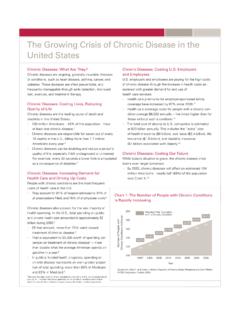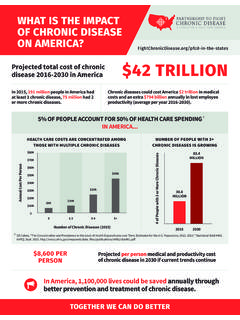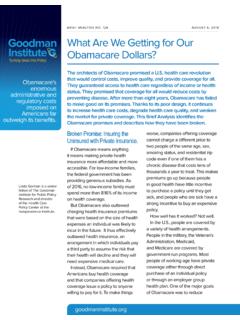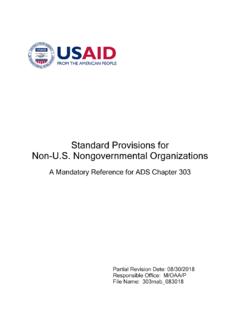Transcription of Multiple Chronic Conditions in the United States
1 Multiple Chronic Conditions in the United States Christine Buttorff, Teague Ruder, and Melissa Bauman C O R P O R AT I O N. A. For more information on this publication, visit Library of Congress Cataloging-in-Publication Data is available for this publication. ISBN: 978-0-8330-9737-8. Published by the RAND Corporation, Santa Monica, Calif. Copyright 2017 RAND Corporation R is a registered trademark. Limited Print and Electronic Distribution Rights This document and trademark(s) contained herein are protected by law. This representation of RAND. intellectual property is provided for noncommercial use only. Unauthorized posting of this publication online is prohibited.
2 Permission is given to duplicate this document for personal use only, as long as it is unaltered and complete. Permission is required from RAND to reproduce, or reuse in another form, any of its research documents for commercial use. For information on reprint and linking permissions, please visit The RAND Corporation is a research organization that develops solutions to public policy challenges to help make communities throughout the world safer and more secure, healthier and more prosperous. RAND is nonprofit, nonpartisan, and committed to the public interest. RAND's publications do not necessarily reflect the opinions of its research clients and sponsors.
3 Support RAND. Make a tax-deductible charitable contribution at iii Preface I n 2014, 60 percent of Americans had at least one Chronic condition, and 42 percent had Multiple Chronic Conditions . These proportions have held steady since 2008. Americans with Chronic Conditions utilize more and spend more on . health care services and may have reduced physical and social functioning. This chartbook updates previous versions with more recent data on the prevalence of Multiple Chronic Conditions (2008 2014) and associated health care utilization and spending. It explores disparities in the prevalence of Chronic Conditions and associated utilization of health care services and analyzes functional or other limitations for those with Multiple Chronic Conditions .
4 This chartbook should be of interest to researchers, policymakers, and practitioners, as well as to the general public. The authors would like to thank the Partnership to Fight Chronic Disease for providing support for this project. We also thank our reviewers, Chloe E. Bird, , and Gerard F. Anderson, , for lending their expertise to this report. This research was conducted in RAND Health, a division of the RAND Corporation. A profile of RAND Health, abstracts of its publications, and ordering information can be found at I. iv Contents iii Figures and Chapter 1: Prevalence of Multiple Chronic Chapter 2: Health Service Use and Chapter 3: Functional Status of Adults with Multiple Chronic Appendix: Detailed Methodology and II.
5 V Figures and Tables Figure Percentage of Adults with Chronic Conditions , by Number of Chronic Conditions (2014)..6. Figure Prevalence of Multiple Chronic Conditions , by Age (2008 2014)..7. Figure Prevalence of Multiple Chronic Conditions by Age and Gender (2014)..8. Figure Percentage of Adults with One or More Chronic Conditions by Race/Ethnicity (2014)..9. Figure Prevalence of Top Chronic Conditions , Figure Most Common Chronic Conditions in 2008 and 2014, 11. Figure Most Common Chronic Conditions in 2008 and 2014, Figure Annual Service Utilization by Number of Chronic Conditions (2014)..14. Figure Prevalence and Spending by Number of Chronic Conditions (2014).
6 15. Figure Health Care Spending by Number of Chronic Conditions (2014)..16. Figure Average Annual Health Care Expenditures, by Number of Chronic Conditions and Insurance Figure Out-of-Pocket Spending by Number of Chronic Conditions and Insurance Figure Functional, Physical, Social, and Cognitive Limitations, by Number of Chronic Conditions (2014)..19. Figure ADL, Instrumental ADL, and Cognitive Limitations by Age and Number of Chronic Conditions (2014)..20. Figure Prevalence of Multiple Chronic Conditions (2003 2014)..25. Figure Prevalence of Multiple Chronic Conditions in Adults Age 65 and Older, 2008 Table Decision Rules for Imputing Masked iii Introduction | 1.
7 Introduction S ix in ten adult Americans had at least one Chronic condition in 2014, the latest year for which data are available, and four in ten had more than one. As this chartbook shows, Chronic What is a Chronic condition? disease is a burden not only for these patients but also for the A Chronic condition is a physical health care system overall. Those with Multiple Chronic Conditions or mental health condition that have poorer health, use more health services, and spend more lasts more than one year and on health care trends that have been stable since 2008. causes functional restrictions or requires ongoing monitoring or This chartbook assesses the prevalence of Multiple Chronic Conditions in the United States and explores the associated When a patient has more than one health care utilization and medical spending.
8 This version Chronic condition for example, updates and expands on previous editions: the Agency for diabetes, hypertension, and Healthcare Research and Quality's (AHRQ's) 2014 edition of mood disorders treatment can be difficult to manage. Treatment the Multiple Chronic Conditions Chartbook,10 as well as previous strategies or drug regimens iterations from the Robert Wood Johnson Foundation and Johns may be similar but can be Hopkins , 12 very different and one Chronic condition may be better managed The data confirm that the prevalence of Multiple Chronic than the Conditions that is, having two or more Chronic diseases simultaneously is highest among older adults.
9 It also shows that women are more likely than men to have Multiple Chronic Conditions , as many women live longer than men do. The 1. Introduction | 2. prevalence of Multiple Chronic Conditions is higher in non- Hispanic whites than in other racial/ethnic groups, which may reflect differences in access to care, rather than in the actual prevalence of Chronic disease. In addition, those with more Conditions have greater reported functional, social, and cognitive limitations. For policymakers, planning for the care of people with complex Chronic Conditions is increasingly urgent as baby boomers become eligible for Medicare. Previous work has shown that people with Multiple Chronic Conditions face more financial obligations and functional limitations2, 3 and often have worse health , 5, 6 Other work has shown that people with Multiple Chronic Conditions have higher hospital readmission rates7 and much higher health care Multiple physical health Conditions can be difficult to manage, especially when coupled with depression or other mental health Conditions .
10 In addition, younger generations can be affected by the financial and social implications of caring for the millions of older 2. Methodology | 3. Methodology T his study uses the Medical Expenditure Panel Survey (MEPS) from MEPS is a publicly available, nationally representative sample of the civilian, noninstitutionalized population. It is important to note that institutionalized adults are excluded from the charts because they are not included in the MEPS data. For the purposes of this chartbook, we define Multiple Chronic Conditions as having two or more Conditions . We used the MEPS. survey weights to create nationally representative estimates.







